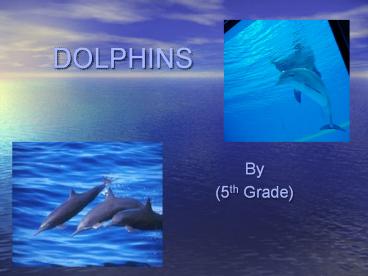DOLPHINS - PowerPoint PPT Presentation
Title:
DOLPHINS
Description:
DOLPHINS By (5th Grade) * * * * * * * * * Biome Dolphins live in the Aquatic Biome. This biome can be broken down into two basic regions: Freshwater and Marine The ... – PowerPoint PPT presentation
Number of Views:324
Avg rating:3.0/5.0
Title: DOLPHINS
1
DOLPHINS
- By
- (5th Grade)
2
Biome
- Dolphins live in the Aquatic Biome.
- This biome can be broken down into two basic
regions Freshwater and Marine - The bottlenose dolphin is found worldwide in
tropical and temperate marine ocean waters. - The largest of all the ecosystems, oceans are
very large bodies of water that dominate the
Earths surface.
3
Biome
- Bottlenose Dolphins live in the pelagic zone of
the ocean, which includes those waters further
from the land, basically the open ocean. - The pelagic zone is generally cold.
4
Biome
- The flora in the pelagic zone include surface
seaweeds. The fauna include many species of fish
and some mammals, such as whales and dolphins. - Many feed on the abundant plankton.
5
Habitat
- Bottlenose dolphins are found from northern Japan
and California to Australia and Chile and in
worldwide oceans. - Bottlenose Dolphins can be found in harbors,
bays, lagoons, gulfs, and estuaries.
6
Food Chain
- Tiger, Bull and Dusky Sharks are the main
predators. They also get caught in fishermens
nets as they fish for tuna. - Dolphins are hunters and they mainly eat fish and
squid. - They hunt near the surface of the water.
7
Interesting Facts
- Dolphins are not fish they are considered
mammals. - They breathe air directly into their lungs.
- They are warm-blooded.
- They give birth to live young.
- They are like small whales, and can swim more
than 25 miles per hour. - They have 94 teeth and they travel in groups
called pods.
8
Bottlenose DolphinBehavior
- They are known for their playful behavior.
- They can jump 20 feet.
- When hunting they chase fish toward shallow
water. - They corral schools of fish and take turns
swimming into the school to feed. - Watch this video.
9
Bottlenose DolphinBehavior
10
Structure and Function
- Stream-lined bodies and a rounded head with a
distinctive beak. - They have a tall, falcate (sickle-shaped) dorsal
fin and broad, slightly pointed flippers. - Use their tail flukes when hunting, by hitting a
fish up into the air with their tail, stunning
it, then scooping the fish up when it falls back
into the water.
- Melon is fatty and helps direct sound.
11
Communication
- Dolphins use snaps and whistles to warn other
dolphins of predators.
12
Adaptations to Survive
- Bottlenose dolphins have a layer of blubber under
their skin to keep warm. - During a deep dive (up to 1000 feet) their lungs
and ribs partially collapse. - They store oxygen in their blood and muscles
instead of their lungs.
13
Evolution
- Inside their pectoral fins, dolphins have a
skeletal structure similar to a human arm and
hand. - They have a humerus with a ball and socket joint.
- They have a radius and ulna, as well as a
complete hand structure, including five finger
bones. - This makes scientists think dolphins evolved from
a terrestrial ancestor.
14
Evolution
Diagram of a dolphin dorsal fin bone structure
and a human arm and hand bone structure.
15
Life Cycle
- Bottlenose dolphins breed in early March to mid
May. - Baby dolphins grow to an adult dolphin and then
reproduce. - Dolphins can live up to
- twenty five years
- in the wild.
16
Reproduction
- When dolphins mate, they don't really get
married. - They just swim belly to belly for about 30
seconds. - The average time a calf grows inside a mother is
about 10-12 months. - Calves have to be born tail first otherwise they
will probably drown before they are able to fully
come out of their mother.
17
Reproduction
- After the two dolphins mate and have their baby,
they part, and the mother dolphin takes care of
the baby by herself.
18
Babies
- When they are born, dolphins have whiskers on
their rostrum. - A dolphins whiskers are about one quarter inch
long, and will fall out after birth, because of
water pressure. - Babies stay with their mom 3-6 years.
19
Human Impact
- Bottlenose dolphins have been
- caught for meat, leather, oil, and
- meal (for fertilizer and animal feed).
- Are affected by pollution, heavy boat traffic,
habitat destruction, and competition for schools
of fish by fisheries. - Caught accidentally in fishing nets. Recent
conservation efforts have greatly reduced the
number of dolphin deaths. But scientists believe
that actual deaths may be more than reported.
20
References
- Photos used with permission and retrieved from
http//www.pics4learning.com - Video used with permission and retrieved from
- http//www.nationalgeographic.com/kids/creature_fe
ature/0108/dolphins2.html - Facts
- http//www.dolphins.org/Learn/lmm-phys.htm
- http//www.enchantedlearning.com/subjects/whales/
- species/Bottledolphin.shtml
- http//www.aqua.org/downloads/pdf/Dolphins.pdf
- Kovacs, Deborah. All About Dolphins! Bridgeport,
Connecticut Third Story Books, 1994. - Gay, Tanner Ottley. Whales and Dolphins in
Action. New York Aladdin Books, 1991.































